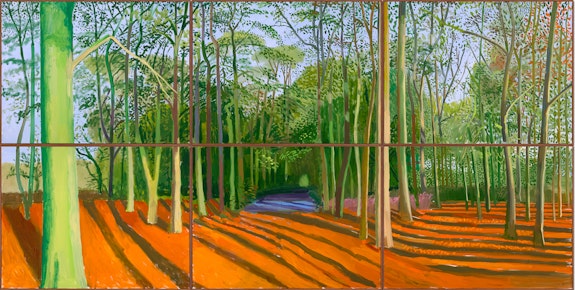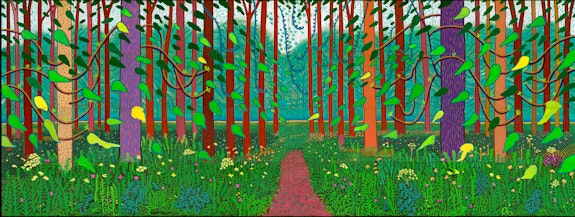ArtSeen
Hockney-Van Gogh: The Joy of Nature
On View
Van Gogh MuseumMarch 1 – May 26, 2019
Amsterdam
Hockney–Van Gogh: The Joy of Nature is unabashedly a David Hockney (b. 1937) exhibition but with a twist, it winds the modern master's works around his lifelong fascination with Vincent van Gogh (1853-1890). It's a daring pairing, and as Edwin Becker, Head of Exhibitions at the Van Gogh Museum, told me, "It's the first time we've dedicated our whole special exhibition wing to a contemporary artist. We primarily put Van Gogh into context with his contemporaries and friends, but we were influenced by Hockney's strong connection with Van Gogh—not just his paintings and drawings—but his mentality and subjects."
One would expect few Hockney surprises since his three 2017 blockbuster collaborative retrospectives at the Met, Centre Pompidou, and Tate Britain. But this exhibition of his late Yorkshire landscapes ambush that thought as soon you enter the first gallery space where nine splendid mural-sized Hockney paintings hang on yellow, violet, brick-red and white walls. Woldgate Woods (2006), consisting of four six-panel paintings depicting the four seasons, sweeps cinematically across a long curved wall, their sizzling electrified colors psychedelically reimagining the natural November underbrush as a blazing sunset-orange; in March it yields to a blue and red-flecked lavender-ribboned path, and by July both the ground and the abundant forest of sturdy and spindly trees surrender to a dappled merge of vibrant green foliage. Together with The Arrival of Spring in Woldgate, East Yorkshire (2011) and Under the Trees, Bigger (2010-2011), these works, in size, scale, and color, initially overpower five modest-sized Van Gogh paintings quietly occupying two white pillars in the center of the room. However, like nature's shifting moods, this is a fleeting sensation.
What Van Gogh's presence gives us that the extravagant retrospectives did not, is the vital role the 19th century painter played in the evolution of Hockney's late-career subjects and style. Hockney marveled at how Van Gogh saw nature and revealed the way his paintings were made. The exhibition, for example, draws a direct sight line from Hockney's The Arrival of Spring in Woldgate, East Yorkshire (2011) to Van Gogh's Undergrowth (1889). Hockney's panorama of an enormous forest directs our gaze downward towards the small stuff: newborn grasses, weeds, and blossoms making their way into the world. Van Gogh's Undergrowth, a comparatively modest-size painting also concentrates on a patch of forest exploding new life. The shimmering light and virtuosity of every Van Gogh brushstroke vibrates with the rapid energy driving the artist's hand, so much so that the undergrowth seems alive, even today. He depicts cropped tree trunks—standing erect or aslant and curved in near embrace; he honors the way each blade of grass bends towards light and with the breeze, giving it a thick flick of paint all its own as he weaves an impasto carpet of variegated yellows, blues, oranges, greens, and purples. Thus is each Van Gogh brushstroke to a painting what a blade of grass is to a verdant green field. As Antonin Artaud eloquently put it in his essay "Van Gogh, The Suicide Provoked by Society":
I will tell you that Van Gogh is a painter because he has reassembled nature, because he has, as it were, perspired it and made it sweat, because he has spurted on to his canvases in heaps, monumental with colors, the centuries-old struggle of elements, the terrible rudimentary pressure of apostrophes, stripes, commas and strokes…
It's little wonder that Hockney found a kindred spirit in Vincent Van Gogh. The 11 Van Gogh works on view representing the Dutch artist's Arles period follow his flight from the beclouded Netherlands to Paris, then on to Arles in southern France. Once he saw nature through the prism of dazzling light, he abandoned the earthy dank palette of his iconic Potato Eaters (1885) to revel in a swirl of cobalt-blue skies and golden wheatfields. Hockney made the 64 landscapes featured in this exhibition when he relocated from his adopted home in Los Angeles, California to his native Yorkshire in 2004, a move which allowed him to see anew the sooty grey skies he recalled from childhood, and to begin a late-career love fest with nature. He quickly unleashed and intensified the sun-shined color animating his West Coast works onto a new generation of fantastically vibrant landscape paintings.
In a 10-minute introductory film to the exhibition, Hockney pays tribute to Van Gogh, referring to him as the first great colorist who clearly saw space. In a 2018 catalog interview with Hans den Hartog Jager, he further remarks that Van Gogh "creates a spatial experience by using all these different colors, twenty different kinds of green." This fascination, on the part of both artists, with color as a means of reinventing space defines much of this show, which is clear in Hockney's Woldgate Vista 27 July 2005, homage to Van Gogh's The Harvest (1888). Hockney replicates Van Gogh's lively dance of summer grasses as they abut tiers of yellow and green fields extending vertically towards an azure sky. But unlike Van Gogh, who includes a narrative about the toil of workers with his placement of a figure, haystacks, and ladders in the field, Hockney is more interested in simplified color patterns. He reduces Van Gogh's frenzy of grasses to more abstract expressions of movement, distilling them to a battalion of crowded brushstrokes swaying to their own rhythms.
Indeed much of the rigor of this exhibition draws from an Artaud-like play of follow-the-dots, dashes, commas, swirls, and spiky lines leaping from Van Gogh into Hockney paintings and then figuring out what makes each work a work of its own time. The same universe of painterly marks in Van Gogh's Trees (1887), for example, re-emerge in Hockney's ébouillent May Blossom on the Roman Road (2009), but here the bushes and plants spewing new yellow blossoms cast finger puppet-like shadows on a winding flat plane of orange road. Recalling the flagrant sexuality of his early homoerotic works, Hockney has some fun with nature's sensuous urges, depicting proud, pregnant and phallic forms rising like huge Disney World balloons against a baby-boy blue and girly pink confection of sky. "There is a moment when nature has an erection. It looks like champagne has been poured over the bushes and it looks marvelous," Hockney exclaims in the video. While he humorously transcribes Van Gogh's hungry lapping brushstrokes into crisply defined graphic forms, he doesn't lose his hero's sensitivity to the brevity of nature's moods and cycles, sharing his eagerness to capture them en plein air. As Hockney expressed his race to paint spring's explosive moment in a day or two, so did Van Gogh in a letter to his brother Theo cry out, "for Christ's sake, get the paint to me without delay. The season of orchards in blossom is so short."
This immediacy—this inner drive to capture an instant of time—flows from these artists' works through the entire exhibition. It casts Hockney and Van Gogh and their passion for nature and art making as romantics straddling their own timelines, relentlessly experimenting with all the devices and techniques available to them. Van Gogh early on tried a perspective frame to achieve illusionist space then discarded it, just as Hockney made extensive studies of the camera lucida and other art historical perspective devices to toss them away because single-point perspective stifled him. Neither artist cared much for photography, though Hockney used it as a tool. For Van Gogh, the invention of chemical paints in easily portable tubes allowed him to use light-catching pigments. He also experimented with all types of drawing devices, papers and pens that allowed him to work rapidly and create multiple textural effects. Technology—computers, iPads, iPhones—served much the same purpose for Hockney, enabling him to alter the world before his eyes using digital color, and to draw looking out the window from his bed as spontaneously as he could sketching outdoors.
Both artists embraced non-Western forms in their quest to create a new kind of space. Van Gogh collected, copied, and appropriated the bold forms and flattened space of Japanese prints; Hockney found inspiration in Chinese scrolls that cinematically unfurled visual narratives. It's a lot to digest, but this exhibition seamlessly enables us to grasp how the profound impact of these phenomena made soul mates of artists living a century apart.
This exhibition stresses the vital role drawing played for Hockney and Van Gogh, as works unto themselves and as studies informing their paintings. For Thistles by the Roadside (1888) Van Gogh used a combination of pencil, pen, reed pen, and ink to depict an unruly burst of roadside flora. A barrage of irregular dots sets the ground for an untidy clump of thistles; their struggling buds springing like spermatozoa from stalks of weedy leaves. Negative space recalling Japanese prints defines the middle ground, as the scene rises towards an expanse of planted crops that merges with a scribble of trees located along the distant high horizon line. Field with Irises near Arles (1888) is a compositionally similar painting in which Van Gogh relies on orchestrations of color, line, and space to move the eye upward from a stretch of blue irises dominating bands of stippled color bathed in warm sunlight.
An animated video of one of Hockney's iPad drawings, The Arrival of Spring in Woldgate, East Yorkshire in 2011 (twenty eleven) reveals the influence of Van Gogh's drawing practice. It's amazing to watch the progression of markings, so similar to those used by Van Gogh, grow vastly different results—linear and graphic as opposed to dense and textural— when the pen or brush is traded for a Brushes app and digital color. Hockney's debt to the multiplicity of Van Gogh's drawn markings is even more telling in The Arrival of Spring in 2013 (twenty thirteen), a series of 25 charcoal drawings that in black and white manages to suggest color through its variety of textures and plays of light and dark.
Hockney also commandeered the video camera as a live-action drawing tool. For his celebrated series, The Four Seasons, Woldgate Woods (Spring 2011, Summer 2010, Autumn 2010, Winter 2010), (2010-11), Hockney mounted nine video cameras on an SUV to produce four separate seasonal videos of the same woodsy landscape. Each composite nine-frame video forces the viewer to see the landscape as one does walking through a forest space—eyes on the move, absorbing multiple perspectives; the path through the woods seen in reverse perspective, all of which encompasses the viewer in a kaleidoscopic panorama of time, space, and place.
A metaphoric path meanders through this entire exhibition. It appears in Van Gogh's The Garden of Saint Paul's Hospital (Leaf-Fall) (1889) featuring a lone figure stepping onto a road winding through a forest. He painted it when he voluntarily entered an asylum to be treated for his mental afflictions. The abruptly truncated path of Wheatfield with Crows (1890), one of his last paintings (on view in the Van Gogh Museum permanent collection), for most represents the tragic end of his journey. Hockney relies on a path in most all his series in this exhibition as a road into his compositions, into the world of nature, and into his own artistic odyssey. But overall this exhibition has less to do with comparing brushstrokes or paths through the forest and much more to do with what drove these artists to seize the moment and the brush to extrapolate from the natural world their unprecedented visionary landscapes.




